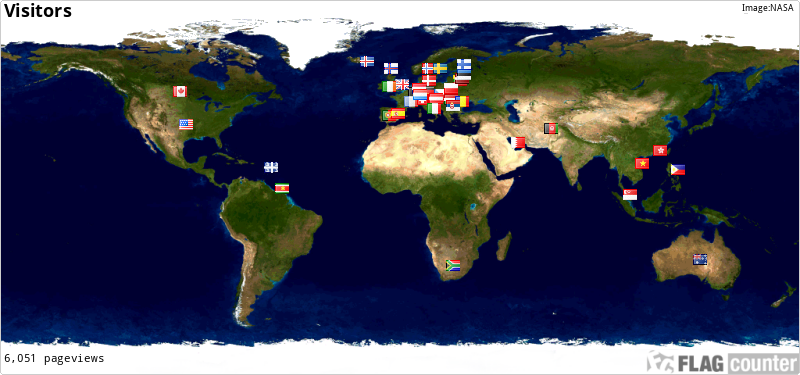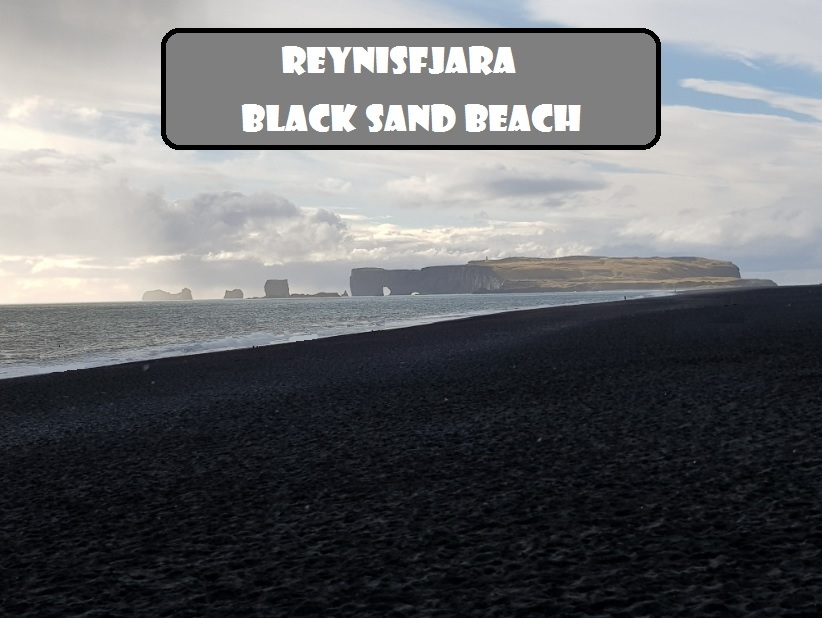
The coordinates will lead you to Reynisfjara that is a world-famous black-sand beach found on the South Coast of Iceland, just beside the small fishing village of Vík í Mýrdal. It is a beach made out from lava and lava ashes. Don’t be confused with the “same” different names that goes around here, so here is an overview:
* Reynisfjara is the black sand beach
* Reynisfjöru is the local word for Reynisfjara
* Reynishverfi is the village and area next to the black sand beach
* Reynisdrangar is the 66 m high rock pillars that stick out of the sea
* Reynisfjell is the 340 m high mountain with hexagonal-shaped basalt columns at the bottom
The local geology of Reynisfjara.
The basic way to explain the geology of Iceland is that the island is placed over a hot spot.
Iceland has formed by the coincidence of the spreading boundary of the North American and Eurasian plates and a hotspot or mantle plume – an upsurge of abnormally hot rock in the Earth´s mantle. As the plates moved apart, excessive eruptions of lava constructed volcanoes and filled rift valleys. And that is how this part of Iceland and this Valley has formed. With the volcanic act this beautiful landscape has been built up.
The lovely and extraordinary landscape that you can view here at the south coast of Reynisfjara is just stunning. The black sand beach reach out for about 100km in total from the south, towards the west. These areas are world know and was in 1991 voted and ranked among the top ten list of the 10 most beautiful non-tropical beaches in the world by the National Geographic. Reynisfjara Black Sand Beach is surrounded by incredible basalt columns, lava formations, towering cliffs, and caves. All raised and formed by volcanic basalt.
We can`t expect a fine grained black sand to be found here at the location, but it is actually a various size of shiny black pebbles. You could call it rugged and wild, and very different from white sand beaches.
Reynisfjara Volcanic sand:
Sand samples of volcanic origin are of two dominant types: clastic detritus eroded from a volcanic terrain and products of explosive volcanic eruptions (pyroclastic sediments, also known as tephra).
The first group of volcanic sand is similar to most other types of sand in terms of genesis. However, they generally have different composition from the so-called normal continental quartz-rich sand. Such volcanic sand is typically immature because most of its components are susceptible to weathering. This type of sand is often composed mostly of rock fragments rather than individual mineral crystals.
The second group consists of volcanic ash. This material is composed of volcanic glass, rock fragments, and crystals in all possible proportions. Lithified volcanic ash is tuff. Lithified deposit of a pyroclastic flow is ignimbrite.
Olivine, pyroxene, and magnetite are the most characteristic minerals of most volcanic sand deposits. Most volcanic beach sands are dark-colored. Hence, they are often named black sand. Black color is given to these sands by minerals augite (pyroxene), magnetite, and sometimes hornblende. These minerals contain lots of iron in their crystal structure which often gives them black color and reddish rust-colored hue when weathered.
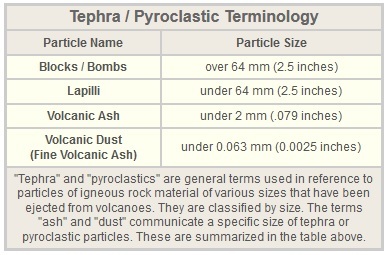
Black sand can be seen as a layer on top of silica sand in regions with high wave energy, on the flanks of volcanoes, and in areas where most of the source rock is mafic, or dark-colored and poor in silica. It can be composed of a number of different dark minerals - most are iron-rich and heavier than silica sand. This weight enables it to remain when high-energy waves wash the lighter sand grains out into the surf zone.
Mafic rocks such as basalts (like those produced on Mauna Loa), gabbro (an intrusive igneous or plutonic rock), and other dark-colored low-silica rocks will erode down to components that are also dark. The serpentinized basalt at left is a metamorphic rock - basalt that was pressurized and subjected to high heat. The west coast has a great deal of this type of rock, and much of the black sand found on beaches in that region come from rocks like this one.
Some dark-colored minerals, like magnetite, are magnetic. You could take a magnet with you to the beach and run it through the sand, magnetite will stick to the magnet. You might want to cover it with plastic first, the magnet will still work, and it's easier to get clean. The dark minerals in a beach sand are primarily magnetite and amphiboles, which are non-magnetic black minerals. Both of these mineral types tend to fracture into very small grains that collect on the surface of the sand, by virtue of being smaller and, therefore, lighter. This is an ideal locale type to try out a magnet. You can also find other grain types, and they are primarily multi-colored chert, a type of silica.
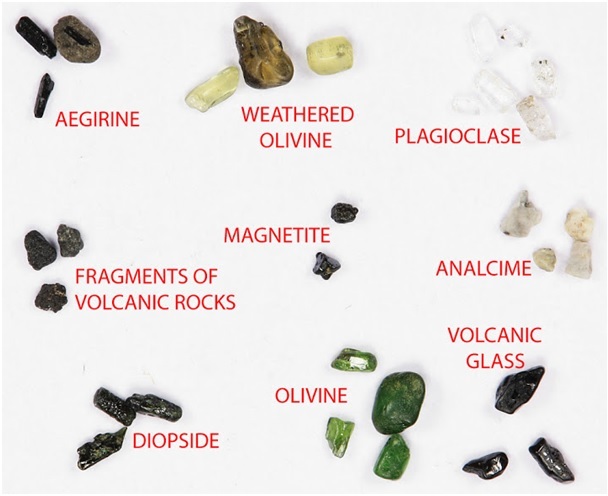

WARNING
Notice, it is highly recommended to follow the warning sign. This area is a danger zone, stay at least 30meters away from the shore line. I understand that you would like a nice, cool and holiday photo for your album, but if you are not alive you will have no use of your photo.
The exactly dangerous sneaker waves are extremely powerful and deadly. Even a calm ocean could send a sneaker wave high up on the beach without warning and suck you out to sea where your are helpless to fight against the strong ocean energy. Don’t go too close to the waves, and never turn your back to the water.
The cave under the basalt rocks are just amazing, but if you go inside, make sure it’s during low tide. You can get trapped inside when the tide is high, and the waves are big and by that drown.
WARNING
To log this cache.
To get to log this cache you will have to visit and answer the questions which are related to the coordinates given the earthcache.
When answers are collected, send them to CO for verification.
You can log immediately after answers are sent CO. If there are any questions about your answers CO will contact you.
Logs without answers to CO or with pending questions from CO will be deleted without any further notice.
Please do not include pictures in your log that may answer the questions.
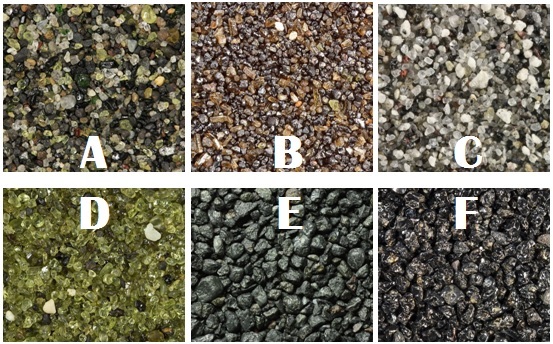
Questions
1. Answer the questions under by visiting the coordinates, and study the location.
A. A-1) Describe the volcanic basalt that makes out the beach here at ground zero, how was it formed? A-2) And what photo from above with A, B, C, D, E, F is the same as from the coordinates?
B. Out of the two volcanic sand types described above, what one is located here at the beach? Describe why you conclude with the type you have chosen.
C. C-1) How big in size/diameter would you estimate the sand and pebbles found on the beach to be? C-2) Describe why you think the sand here is black? (Maybe the overview picture above with fragments and minerals will help you)
2. (It’s voluntary to post a photo in your online log of your visit)
